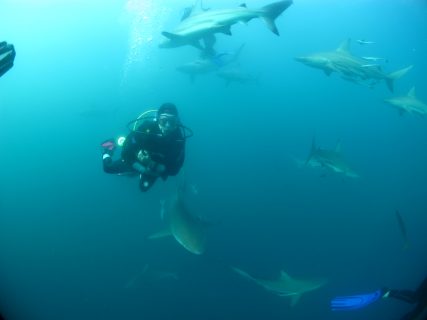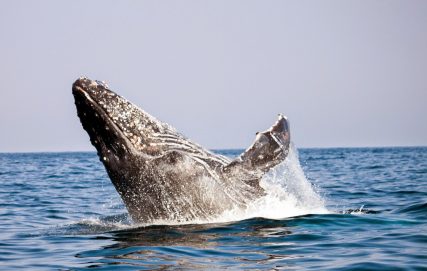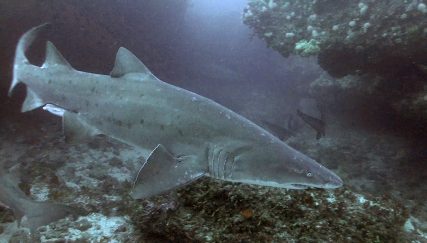Whales, Sharks and Wrecks: Diving Aliwal Shoal

As part of a series of interviews with Dive Butler’s team of vastly experienced divers, we sat down with Barbara Cesario, personal assistant to managing director Alexis Vincent, to chat about her recent trip to South Africa. Dive Butler’s team aren’t afraid to try out new and heart-pumping experiences underwater. In fact, they absolutely thrive on it! Barbara headed off to South Africa in search of some of the ocean’s largest predators.Her trip took her just south of Durban, where the legendary dive sites of Protea Banks and Aliwal Shoal are home to a carnival of shark and marine life activity. Here she tells us about some of her favourite moments diving Aliwal Shoal.
Diving with Humpback Whales

“I have been lucky enough to see a baby humpback whale swimming right behind me at Aliwal Shoal,” Barbara says. “First you hear their incredible music and then turn to see them swimming beautifully right next to you. Words can’t describe it.” It is an experience most divers can only dream about, and while diving Aliwal Shoal might not always produce humpback calves, it certainly won’t fail to impress.
The dive site, which is located three miles (five kilometres) off the coast, is named after the ship the Aliwal, which ran aground and sunk here in 1849. There are dozens of places to dive along the long stretch that makes up the shoal and is almost a mile long. Caves and gullies, pinnacles and a wreck create the perfect environment for eels, rays, turtles and a whole host of sharks, and the warm waters often offer excellent visibility thanks to the Mozambique current.
The varied underwater topography means that diving Aliwal Shoal is well-suited to divers of all experience levels, Barbara explains. And there is plenty to see. There is a wide variety of fish, as well as sharks and eagle rays. “Manta rays are not uncommon,” she adds, “and there is a high chance of seeing dolphins and even whales.” But, according to Barbara, to really experience the magic of this world-famous dive site, the wreck of The Produce should be high on your list.
Diving the Wreck of The Produce
“You need to be lucky with fortune on your side in order to be able to dive this site,” says Barbara. “The weather and sea conditions need to be favourable as it is often hard to pinpoint the exact location of the wreck. Divers will also need to make a quick negative entry, so experience is required.”
The Produce was a Norwegian cargo ship which ran aground in August 1974 and today lies peacefully in some of the deeper waters off the Shoal’s Northern Pinnacles. It is widely considered one of KwaZulu-Natal’s best wreck dives, both for its impressively intact bow and stern sections as well for some unusual residents: a group of the world’s largest reef-dwelling bony fish, the brindle bass.
“The brindle bass remain one of the most impressive things about this wreck,” says Barbara. “You always find them there and they definitely have no intention to leave their territory to opportunistic invaders. Weighing up to 400kg, their sheer size makes them utterly unforgettable.”
“While slowly descending, visibility isn’t at its best,” Barbara adds. “But to see The Produce appearing out of the depths below you for the first time is to experience something truly magical. This wreck has an ethereal power that most divers find utterly captivating. It has some sort of hypnotic power and it feels like it takes you back in time. It feels as though the world around you has just stopped rotating.”
Barbara notes that the list of wreck-dwellers goes far beyond brindle bass. “She is home to thousands of colourful reef fish, including the rare and beautiful harlequin anthias, and also provides shelter for moray eels, lionfish, scorpionfish, and occasionally several species of ray. The Produce is also a fantastic place to spot pelagic species, including kingfish, geelbek and spotted eagle rays.”
Entering an Underwater Cathedral
The Produce might be home to some seriously impressive inhabitants but, according to Barbara, Aliwal Shoal’s most topographically impressive site is the Cathedral. The name speaks volumes, and Barbara describes a vast open-roofed chamber cavern on the outside edge of the shoal. “It really feels as though you are in a cathedral,” she laughs.
While the topography alone is enough to make it a worthy dive site, the Cathedral is also home to many sharks, who take refuge, sleep and reproduce in the sheltered cavern.
“This site is most famous in raggie season,” says Barbara, using the affectionate nickname divers have for the local ragged-tooth sharks. “It is one of the best places on the Shoal to see large aggregations of these impressively photogenic but wonderfully placid sharks. It is also a great place to sift through the sand in search of discarded shark teeth.” A wonderful souvenir of the experience.

Sharks aren’t the only residents here. Against a backdrop of an impressive underwater landscape and with wonderful lighting, the cave makes for an atmospheric place to capture photos of rays, giant cuttlefish and moray eels. Perched on the edge of the shoal, with the deep blue stretching off into infinity, the Cathedral is also a fantastic spot for spying large pelagic species, says Barbara. Humpback whales, hammerhead sharks and even thresher sharks have been spotted swimming past the Cathedral. So be sure to keep one eye on the blue and don’t get too mesmerised by the ethereal atmosphere inside the cavern.
« Scuba Diving South Africa’s Sardine Run | Diving with Sharks in Protea Banks, South Africa » |